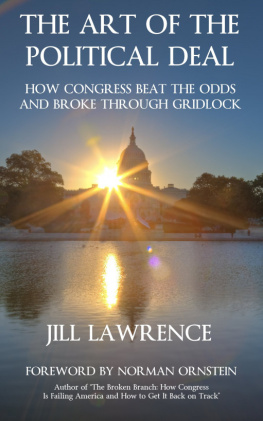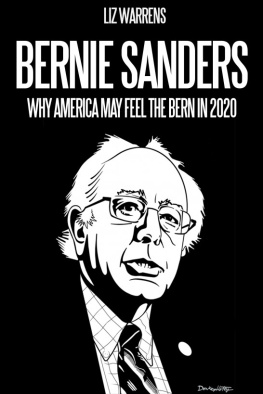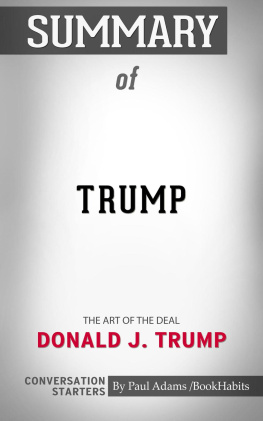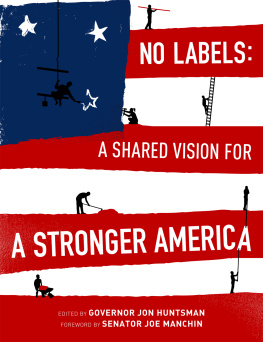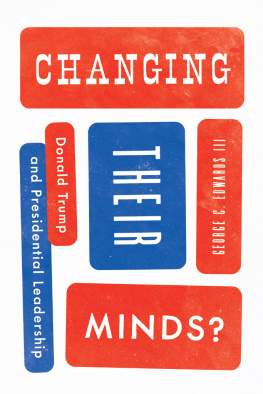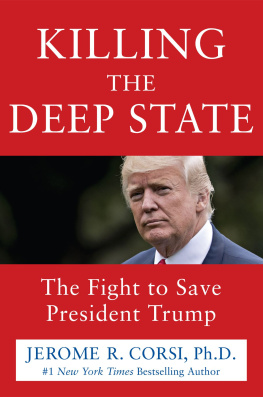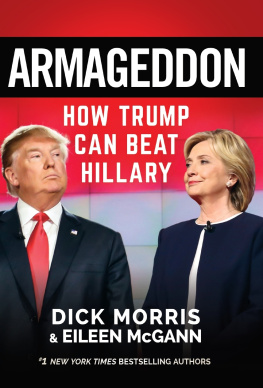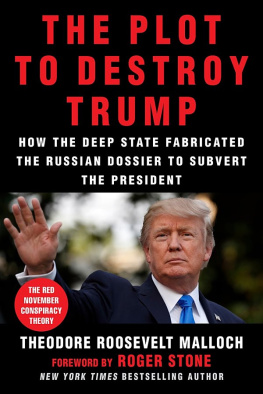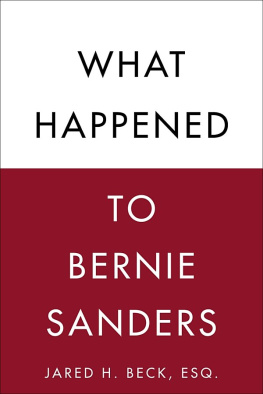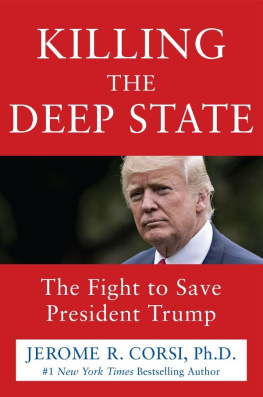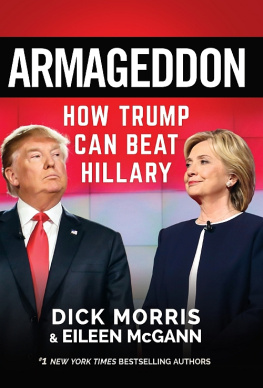PRAISE FOR THE ART OF THE POLITICAL DEAL
Could not be more timely. These cases are notonly insightful about the dynamics of negotiation in Congress, theyare also beautifully readableactual page-turners. Highlyrecommended.
Jane Mansbridge, Adams Professor ofPolitical Leadership and Democratic Values at Harvards KennedySchool of Government and co-editor of PoliticalNegotiation: A Handbook
Legislative sausage-making that you do, in fact,want to see. Jill Lawrence provides a fascinating behind-the-sceneslook at how the hard work of legislating, compromise andconsensus-building actually unfolds on Capitol Hill.
Former Senator Olympia Snowe,Republican of Maine, a senior fellow at the Bipartisan PolicyCenter and co-chair of its Commission on PoliticalReform
A little gem of a book. It shows that positivethings can still happen even amidst partisan rancor.
Elaine Kamarck, Founding Directorof the Center for Effective Public Management and Senior Fellow inGovernance Studies at the Brookings Institution
Worked really well in my Congress class. Thesecase studies are especially valuable because they spell out theconditions that give rise to effective bargaining.
John J. Pitney, Roy P. CrockerProfessor of Politics at Claremont McKenna College
Are you looking for a ray of hope at a time ofgloom and doom about poisonous partisanship? If so, you need toread Jill Lawrences The Art of the PoliticalDeal . When the big players want to work across the aisleto get something done in the national interest, they stillcan.
Larry Sabato, director of theUniversity of Virginia Center for Politics and author of The Kennedy Half-Century: The Presidency, Assassination, andLasting Legacy of John F. Kennedy
The Art of the PoliticalDeal is a must-read for all Americans. Jill Lawrencesin-depth interviews and deep knowledge about how Congress worksbring to life the personalities, process and politics of tough butsuccessful negotiations. She shows that compromise, pragmatism andbipartisanship are not dead on Capitol Hill.
James Thurber, founder of AmericanUniversitys Center for Congressional and Presidential Studies andco-author of American Gridlock: The Sources, Characterand Impact of Political Polarization
Highly recommended to anyone who wants tounderstand how Capitol Hill works. Jill Lawrences collection ofcase studies illustrate how some of the best-known figures inCongress, such as Paul Ryan and Bernie Sanders, worked with avariety of lesser-known lawmakers to achieve the compromises thatmade the passage of important bills possible.
Chuck McCutcheon, co-authorof The Almanac of American Politics ( 2012 and 2014 editions) and Dog Whistles, Walk-Backsand Washington Handshakes: Decoding the Jargon, Slang, and Blusterof American Political Speech
THE ART OF THE POLITICAL DEAL
How Congress Beat the Odds and Broke ThroughGridlock
JILL LAWRENCE
FOREWORD BY NORMAN ORNSTEIN
Copyright 2017 Jill Lawrence
Most of the material in this bookwas first published by the Brookings Institution in an onlineseries called Profiles in Negotiation. Brookings and Elaine C.Kamarck, Senior Fellow in the Governance Studies Program atBrookings and Founding Director of its Center for Effective PublicManagement, played a central role in the creation of this work.Some material was also published previously by PoliticoMagazine .
Ebook ISBN: 978-0-692-83446-6
Distributed by Smashwords
Cover photo: The U.S. Capitol at sunrise,kropic1/Shutterstock.com
Ebook formatting by www.ebooklaunch.com
CONTENTS
By Norman Ornstein
Do a word game about Congress during the Obamaadministrationwhat one word comes to mind if I say Congress?andthe most common answers would be gridlock, obstruction,partisan and tribal. Those characterizations are notinaccurate. Over a long period of time, going back at least to theGeorge W. Bush era with Dennis Hastert as speaker of the House,Congress has been the broken branch, as Tom Mann and I called itin the title of our 2006 book.
The Constitutions first branch ofgovernment has largely been a desert when it comes to the previousstandard of bipartisan comity. Major legislative accomplishmentswere limited to two years of actions accomplished without minorityvotes, only due to swollen majorities linked to President Obama.But there have been some unnoticed oases of achievement done in thetraditional way.
Jill Lawrence shows us four of these, eachsignificant in its own right, each involving a different set ofHouse and Senate lawmakers, each spanning a huge gulf in ideologybetween the key protagonists, each involving widely disparatepersonalities. It is hard to imagine more differences inbackground, personality and approach than Patty Murray, theDemocratic senator from Washington state, and Paul Ryan, theRepublican representative from Janesville, Wisconsinunless oneconsiders Vermont Senator Bernie Sanders, the fiery independent andself-described democratic socialist, and Jeff Miller, thearch-conservative Republican representative from FloridasPanhandle.
But Murray and Ryan forged a workingrelationship of trust and accommodation to resolve an impasse overthe budget that was a classic example of compromise andgive-and-take. Enough lawmakers of both parties and both housesunderstood the time pressure and the imperatives to actand theconsequences of inactionto pull the compromise over the finishline.
Sanders, after navigating disagreements withhis Senate colleague John McCain, then hit a buzzsaw with Miller.But after a lengthy series of potshots each took at the other, anda period of deep distrust, they found their sweet spot, also drivenby the imperative to act on veterans health issues amidst themajor Department of Veterans Affairs scandal. They reached animportant agreement that ameliorated the urgent problems, even ifthey were unable to solve the issues once and for all.
The other two cases Lawrence details, on thelong-delayed farm bill and its impasse over food stamps, and adifficult public lands package that faced problems among bothDemocrats and Republicans, were different in some ways, but alsoshared key characteristics with the other cases. Each requiredpragmatic lawmakers looking to achieve progress, patience to letobstacles fall away, and leadership support that overcame somestrident opposition. The farm bill was a special case, one thatinvolved years of negotiations and setbacks, of chambers rejectingcareful leadership-driven compromises crafted in a House committeeknown for its bipartisan cooperation, before reaching an agreementthat could pass muster. The public lands case had the advantage ofa number of retiring members who saw an opening to cement theirlegacies.
While there are obvious differences in howthese four success stories played out, there are real commonalitiesabout finding conditions ripe for accomplishment and findinglawmakers with the right skills and mindsets. Jill Lawrence hasherself skillfully and masterfully shown us why and how deals, andlegislative action, are still possible. These well written andlively case studies are valuable for those reasonsbut also as atemplate as we face a new and quite unique set of challenges for aCongress itself wondering how it will operate in the era of aPresident Donald Trump.
Norman Ornstein is a resident scholar at theAmerican Enterprise Institute and co-author of One Nation After Trump: A Guide for the Perplexed, theDisillusioned, the Desperate, and the Not-Yet Deported; Its Even Worse Than It Looks: How the AmericanConstitutional System Collided with the New Politics ofExtremism; and The Broken Branch:How Congress is Failing America and How to Get It Back onTrack .

